How to grow climbing roses
 Bashny.Net
Bashny.Net
Special admiration of gardeners always been climbing rose with its long branches strewn with luxurious flowers. This is a real find for a landscape designer that lets you create flowering arches, columns, pergolas, fences.
Despite the enormous whip, reaching 5-6 m in length, all varieties of climbing roses are shrubs. One would think that in this case, planting and caring for them is similar to other types of roses, but it is not so simple. Long lashes impose special obligations on the owner of a luxury. Therefore, to achieve this by climbing rose aesthetics, it is necessary to know how to properly care for it.
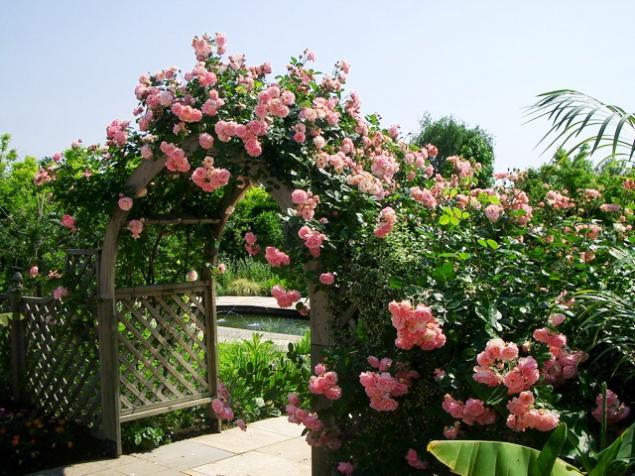
planting time: spring or autumn
? All sorts of "queen of flowers" are considered to be quite capricious, are no exception, and climbing roses care that is necessary to think through every detail. But you must start with the right choice of planting time. It is best to coincide with this event in the warm days of May.
In this case, you're sure to have time to plant winter to get stronger and not die during cold weather. Shrubs climbing roses with a dormant buds can be planted before the trees begin to blossom buds, as soon as the soil warms up to 10-12 °. In that case, if you bought a seedling in a greenhouse (ie leaves), then it is necessary to plant only after bud break in the trees.
You can also planting shrubs in August and September, but then there is always the risk of death of the plant, if it does not have time to properly take root before the frost.
A place for planting
The plot for planting climbing rose should be well lit in the morning. This is important, because it is a warm morning sun will dry the dew on the leaves and give no chance of fungal diseases. Fully open area is not as preferred as the midday sun's rays can cause "burning" delicate petals and even drying of the whole plant.
Be sure to pay attention to the fact that the chosen site was protected from the cold northern and northeast winds, and was not on the corner of the building, where it is constantly walking drafts - delicate climbing rose that does not love, its development will inevitably depressed
<. br> The ground for climbing rose: it is necessary to consider
? Climbing rose develops normally only in permeable soils. This means that the rain (or irrigation) water must flow freely into the ground and does not linger in the root zone. Otherwise, the inevitable decay of the root system and destruction of plants from lack of nutrition.
Therefore, if the ground water in your area are too close to the ground, should the roses planted only at higher elevations. However, if this is not possible, we can proceed in another way: dig a hole to a depth not reaching the ground water level, and then concreted bottom or put to a large flat rock
. This precaution will prevent groundwater "get" to the root zone and damage them also tap roots will not move deep and the bulk of the growth will settle at least not vertically, but horizontally. Then on a stone or concrete is poured a sufficient layer of fertile soil, which subsequently planted plant.
It is best climbing roses grow on fertile loam - they have enough water and breathable to provide good nutrition of the root system. Heavy clay and light sandy soils are not suitable for the cultivation of roses. At the same time, if your site is such soil, do not despair.
It is possible to improve the situation, adding to the clay soil sand and sandy clay diluted. It will handle the soil permeability to air and water, but will not add to the fertility of the soil. In order to improve further and this figure should be made to the soil humus or humus.
The distance between the climbing roses
When boarding card is necessary to ensure a distance equal to between 0, 5 - 1 m and 2.1 m row between rows. In that case, if the planting is carried out near the pergola or wall of the house, then the distance between the plant and the blind area must be at least 0, 35 - 0, 5 m
. You can divide the garden into several zones with the help of espalier, cased climbing roses on both sides. Plants are planted in a staggered manner so as not to obscure one another. The distance between them is stored in 0, 5 - 1 m, as in the conventional scheme landing. This screen is decorative throughout the summer, even when climbing rose bud.
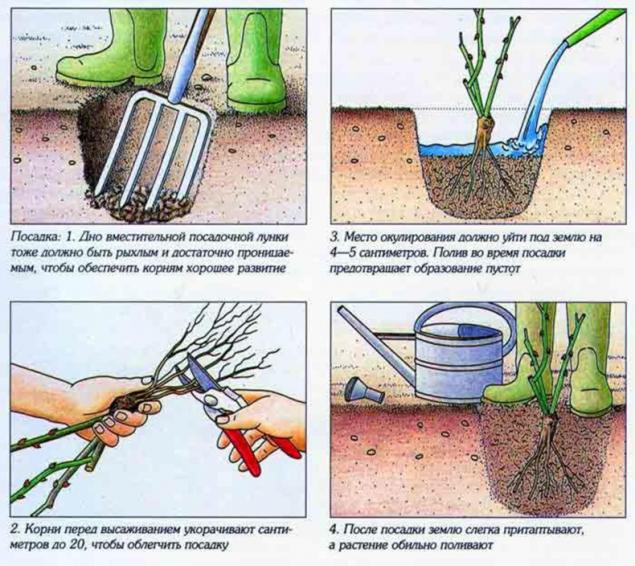
Preparing seedlings for planting
Before you start planting, shrub roses should be examined carefully and remove all broken, rozdroblennye and rotten parts of the root system. Sections for disinfection powdered powdered charcoal to prevent rotting of the received wounds. Further, it is desirable to dip the roots of a mixture of-mash consisting of clay with admixture of fresh mullein (10%) and phosphobacterin. 3 tablets phosphobacterin previously dissolved at 0, 5 liters of water and then this composition is poured into 9 L of 5 talkers. Mullen can be replaced with IAA, adding 1 tablet to 10 liters of mash.
With spring planting seedlings of any kind are subject to pruning climbing rose. Thus on the strongest two shoots developed left kidney, while weak - one. If planting takes place in autumn, the crop is still made in the spring, after removal from the winter shelter bush.
Planting and care for the young seedlings
To start digging a hole, the size of which should provide free placement of the roots, the root neck necessarily bury at least 10 cm. Such a measure will protect it from the winter cold, because at such a depth in the ordinary shelter (for example, under the spruce spruce branches) the temperature does not fall below -2 degrees. Also deepening of the root collar at the own-rooted climbing roses will contribute to the formation of a large number of additional roots.
In the pit poured a mound of fertile land, around which straighten the roots evenly and covered them by leaving voids as possible. After filling in holes underground, ram it down. Non-grafted roses climbing for a better survival rate and sprinkled with a mixture of phosphobacterin IAA.
During the growing season trudging Rose needs regular watering, fertilizing, removing weeds, dried flowers and branches weak.
After removing the winter shelter with the onset of spring warmth spend pruning, remove last year's crop residues are sprayed with pesticides rose, loosen the soil around the plant, make the necessary fertilizer.
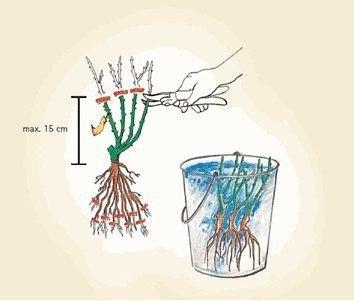
Proper pruning climbing rose
Climbing roses need to be pruned properly, the purpose of which - the formation, obtaining a long and abundant flowering, improvement of the crown. Pruning also helps to get a complete covering of plants with new shoots.
Pruning is carried out after the plant has bud, that is the end of summer. First of all, cut out diseased and damaged branches. Strong annual shoots are not removed. Old shoots are removed if a branch replacement, new shoots. That is pruning produce so that a new, one-year old shoots have come instead. Biennial shoots not cut - it is they will focus the bulk flowers the following summer
.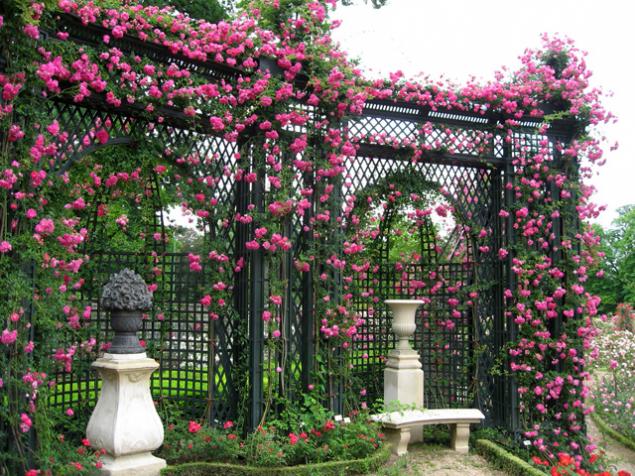
Garter climbing roses
When forming the climbing rose should not be pursued, so that all the main branches grow upward. It may happen that all the flowers and leaves "relocate" to the upper part of the plant, but it does not give aesthetics.
Therefore, to avoid such troubles, you should try to send the main branches horizontally. Then they will soon appear vertical side shoots growing up. This principle of formation of trudging wonderful disguise rose trellis or wall, as well as provide a luxurious and long lasting blooms.
Caring for a climbing rose
winter Winter any rose, including climbing require cover. It is important to know that between the covering (foil, roofing felt, spruce spruce branches), and the plant should remain airspace. If possible, rose vines removed from the support, remove rotten, diseased shoots, as well as all the leaves.
Thereafter branches wrapped with twine and secured to the ground with wooden or metal studs. Top harbor whip tar paper, foil, leaves or spruce spruce branches. Some can also hide climbing rose directly to the support, for example, if it buzz arch. This first pillar is tied with burlap, roofing felt or a film, and then hiding spruce branches.
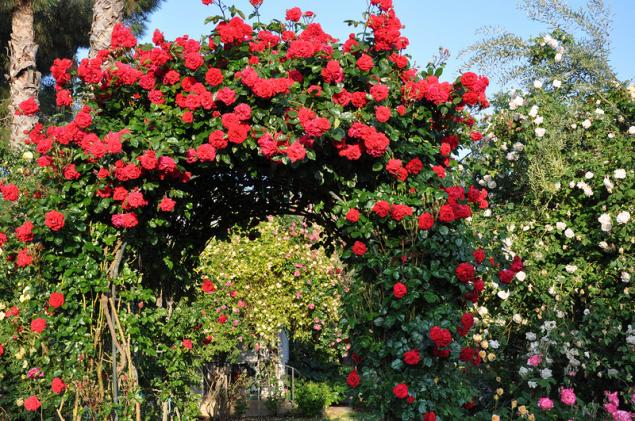
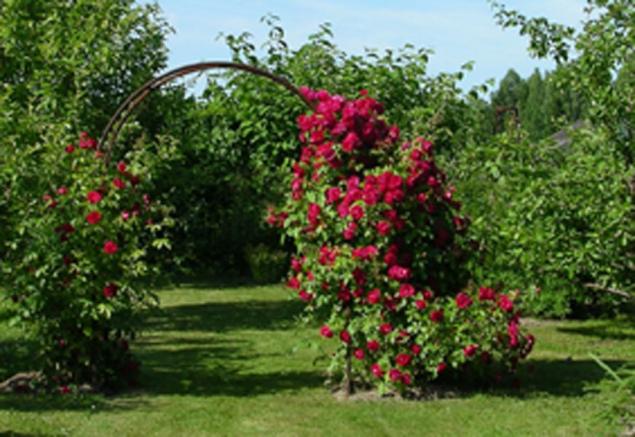


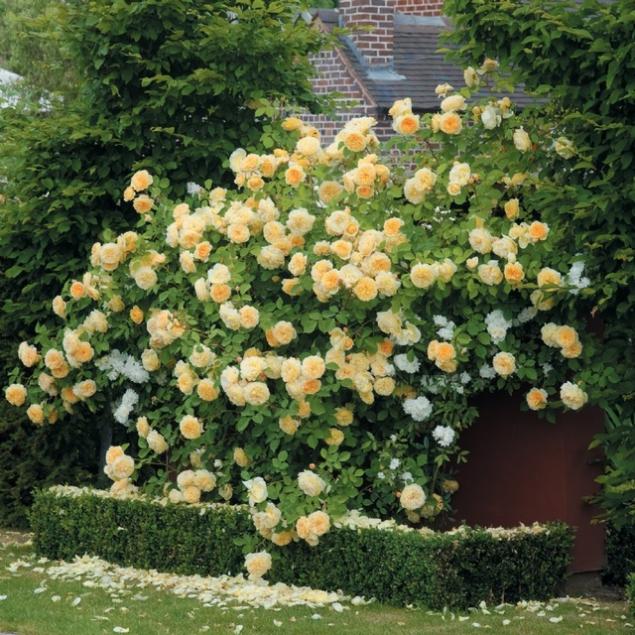

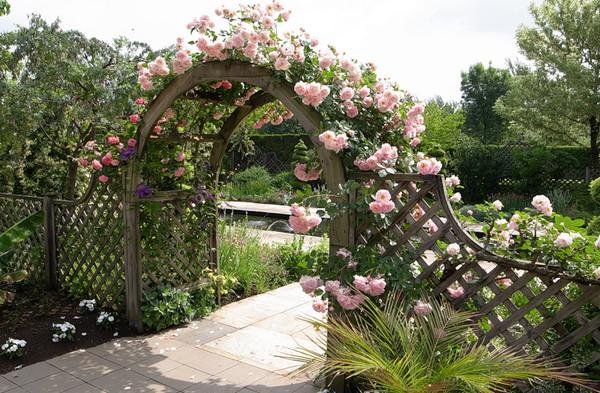
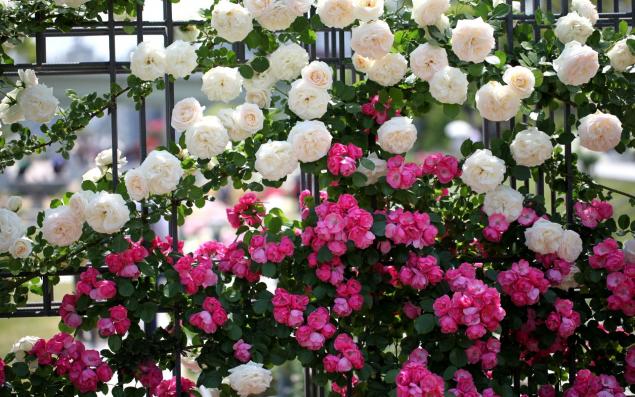
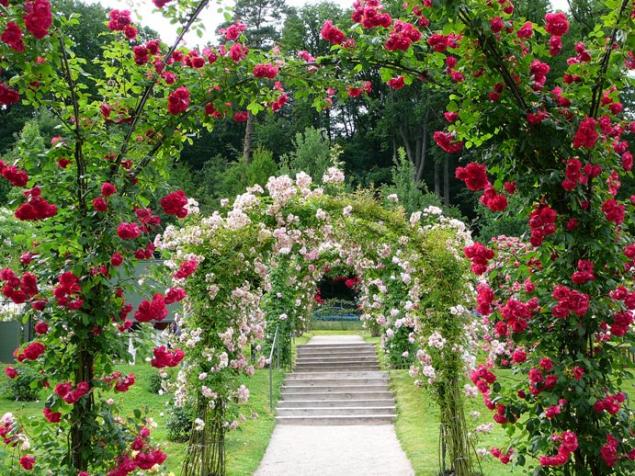

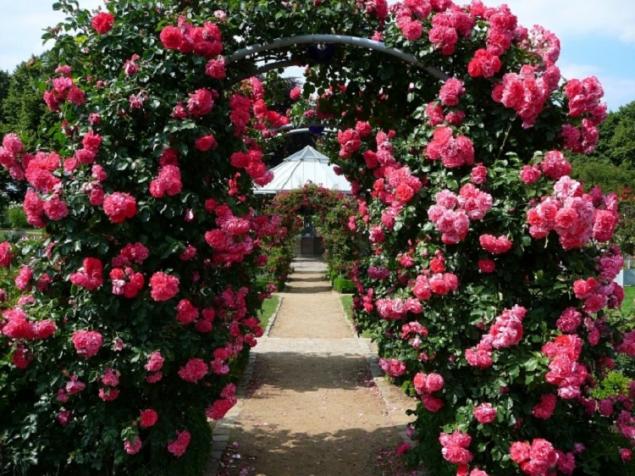
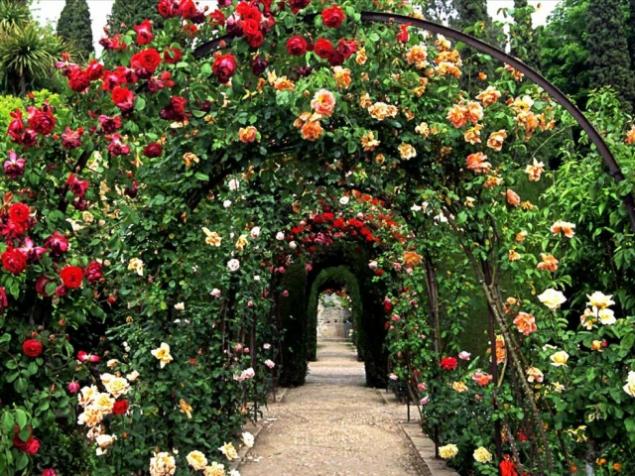
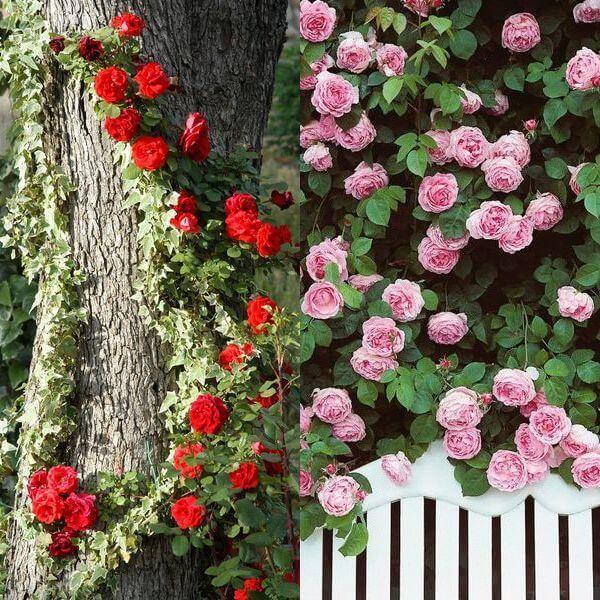


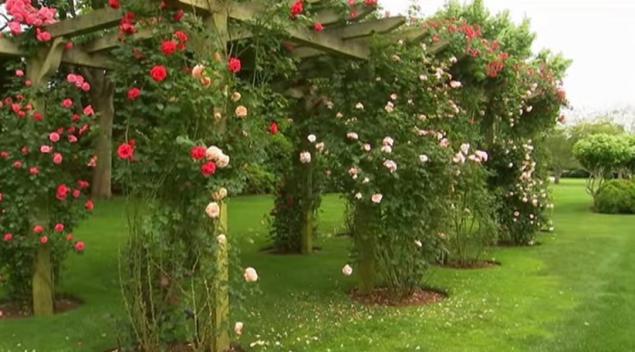




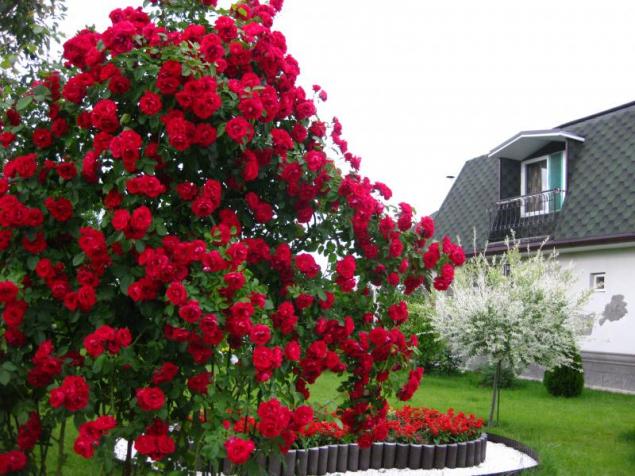
Despite the enormous whip, reaching 5-6 m in length, all varieties of climbing roses are shrubs. One would think that in this case, planting and caring for them is similar to other types of roses, but it is not so simple. Long lashes impose special obligations on the owner of a luxury. Therefore, to achieve this by climbing rose aesthetics, it is necessary to know how to properly care for it.

planting time: spring or autumn
? All sorts of "queen of flowers" are considered to be quite capricious, are no exception, and climbing roses care that is necessary to think through every detail. But you must start with the right choice of planting time. It is best to coincide with this event in the warm days of May.
In this case, you're sure to have time to plant winter to get stronger and not die during cold weather. Shrubs climbing roses with a dormant buds can be planted before the trees begin to blossom buds, as soon as the soil warms up to 10-12 °. In that case, if you bought a seedling in a greenhouse (ie leaves), then it is necessary to plant only after bud break in the trees.
You can also planting shrubs in August and September, but then there is always the risk of death of the plant, if it does not have time to properly take root before the frost.
A place for planting
The plot for planting climbing rose should be well lit in the morning. This is important, because it is a warm morning sun will dry the dew on the leaves and give no chance of fungal diseases. Fully open area is not as preferred as the midday sun's rays can cause "burning" delicate petals and even drying of the whole plant.
Be sure to pay attention to the fact that the chosen site was protected from the cold northern and northeast winds, and was not on the corner of the building, where it is constantly walking drafts - delicate climbing rose that does not love, its development will inevitably depressed
<. br> The ground for climbing rose: it is necessary to consider
? Climbing rose develops normally only in permeable soils. This means that the rain (or irrigation) water must flow freely into the ground and does not linger in the root zone. Otherwise, the inevitable decay of the root system and destruction of plants from lack of nutrition.
Therefore, if the ground water in your area are too close to the ground, should the roses planted only at higher elevations. However, if this is not possible, we can proceed in another way: dig a hole to a depth not reaching the ground water level, and then concreted bottom or put to a large flat rock
. This precaution will prevent groundwater "get" to the root zone and damage them also tap roots will not move deep and the bulk of the growth will settle at least not vertically, but horizontally. Then on a stone or concrete is poured a sufficient layer of fertile soil, which subsequently planted plant.
It is best climbing roses grow on fertile loam - they have enough water and breathable to provide good nutrition of the root system. Heavy clay and light sandy soils are not suitable for the cultivation of roses. At the same time, if your site is such soil, do not despair.
It is possible to improve the situation, adding to the clay soil sand and sandy clay diluted. It will handle the soil permeability to air and water, but will not add to the fertility of the soil. In order to improve further and this figure should be made to the soil humus or humus.
The distance between the climbing roses
When boarding card is necessary to ensure a distance equal to between 0, 5 - 1 m and 2.1 m row between rows. In that case, if the planting is carried out near the pergola or wall of the house, then the distance between the plant and the blind area must be at least 0, 35 - 0, 5 m
. You can divide the garden into several zones with the help of espalier, cased climbing roses on both sides. Plants are planted in a staggered manner so as not to obscure one another. The distance between them is stored in 0, 5 - 1 m, as in the conventional scheme landing. This screen is decorative throughout the summer, even when climbing rose bud.

Preparing seedlings for planting
Before you start planting, shrub roses should be examined carefully and remove all broken, rozdroblennye and rotten parts of the root system. Sections for disinfection powdered powdered charcoal to prevent rotting of the received wounds. Further, it is desirable to dip the roots of a mixture of-mash consisting of clay with admixture of fresh mullein (10%) and phosphobacterin. 3 tablets phosphobacterin previously dissolved at 0, 5 liters of water and then this composition is poured into 9 L of 5 talkers. Mullen can be replaced with IAA, adding 1 tablet to 10 liters of mash.
With spring planting seedlings of any kind are subject to pruning climbing rose. Thus on the strongest two shoots developed left kidney, while weak - one. If planting takes place in autumn, the crop is still made in the spring, after removal from the winter shelter bush.
Planting and care for the young seedlings
To start digging a hole, the size of which should provide free placement of the roots, the root neck necessarily bury at least 10 cm. Such a measure will protect it from the winter cold, because at such a depth in the ordinary shelter (for example, under the spruce spruce branches) the temperature does not fall below -2 degrees. Also deepening of the root collar at the own-rooted climbing roses will contribute to the formation of a large number of additional roots.
In the pit poured a mound of fertile land, around which straighten the roots evenly and covered them by leaving voids as possible. After filling in holes underground, ram it down. Non-grafted roses climbing for a better survival rate and sprinkled with a mixture of phosphobacterin IAA.
During the growing season trudging Rose needs regular watering, fertilizing, removing weeds, dried flowers and branches weak.
After removing the winter shelter with the onset of spring warmth spend pruning, remove last year's crop residues are sprayed with pesticides rose, loosen the soil around the plant, make the necessary fertilizer.

Proper pruning climbing rose
Climbing roses need to be pruned properly, the purpose of which - the formation, obtaining a long and abundant flowering, improvement of the crown. Pruning also helps to get a complete covering of plants with new shoots.
Pruning is carried out after the plant has bud, that is the end of summer. First of all, cut out diseased and damaged branches. Strong annual shoots are not removed. Old shoots are removed if a branch replacement, new shoots. That is pruning produce so that a new, one-year old shoots have come instead. Biennial shoots not cut - it is they will focus the bulk flowers the following summer
.

Garter climbing roses
When forming the climbing rose should not be pursued, so that all the main branches grow upward. It may happen that all the flowers and leaves "relocate" to the upper part of the plant, but it does not give aesthetics.
Therefore, to avoid such troubles, you should try to send the main branches horizontally. Then they will soon appear vertical side shoots growing up. This principle of formation of trudging wonderful disguise rose trellis or wall, as well as provide a luxurious and long lasting blooms.
Caring for a climbing rose
winter Winter any rose, including climbing require cover. It is important to know that between the covering (foil, roofing felt, spruce spruce branches), and the plant should remain airspace. If possible, rose vines removed from the support, remove rotten, diseased shoots, as well as all the leaves.
Thereafter branches wrapped with twine and secured to the ground with wooden or metal studs. Top harbor whip tar paper, foil, leaves or spruce spruce branches. Some can also hide climbing rose directly to the support, for example, if it buzz arch. This first pillar is tied with burlap, roofing felt or a film, and then hiding spruce branches.





















Tags
Personal development
psychology
women
men
relationships
life
happiness
harmony
love
children
money
wealth
success
See also
How to correct the morning 45 minutes can make your day a success.
How to think?
How to manage the savings at any age.
Triangle Karpman or how to act in life
HOW TO DELETE TULLE AND OTHER delicate tissues.
Luxury ideas for creating patios
Metabolic flexibility fitness for your metabolism
Siemens built elektrosamolet with motor performance record
Three things that man is vital to get a woman
What kind of energy is to accumulate a woman

















